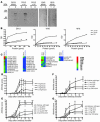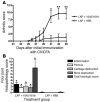Antibodies against citrullinated proteins enhance tissue injury in experimental autoimmune arthritis
- PMID: 16585962
- PMCID: PMC1421345
- DOI: 10.1172/JCI25422
Antibodies against citrullinated proteins enhance tissue injury in experimental autoimmune arthritis
Abstract
Antibodies against citrullinated proteins are specific and predictive markers for rheumatoid arthritis although the pathologic relevance of these antibodies remains unclear. To investigate the significance of these autoantibodies, collagen-induced arthritis (CIA) in mice was used to establish an animal model of antibody reactivity to citrullinated proteins. DBA/1J mice were immunized with bovine type II collagen (CII) at days 0 and 21, and serum was collected every 7 days for analysis. Antibodies against both CII and cyclic citrullinated peptide, one such citrullinated antigen, appeared early after immunization, before joint swelling was observed. Further, these antibodies demonstrated specific binding to citrullinated filaggrin in rat esophagus by indirect immunofluorescence and citrullinated fibrinogen by Western blot. To evaluate the role of immune responses to citrullinated proteins in CIA, mice were tolerized with a citrulline-containing peptide, followed by antigen challenge with CII. Tolerized mice demonstrated significantly reduced disease severity and incidence compared with controls. We also identified novel murine monoclonal antibodies specific to citrullinated fibrinogen that enhanced arthritis when coadministered with a submaximal dose of anti-CII antibodies and bound targets within the inflamed synovium of mice with CIA. These results demonstrate that antibodies against citrullinated proteins are centrally involved in the pathogenesis of autoimmune arthritis.
Figures






Comment in
-
Pathomechanisms in rheumatoid arthritis--time for a string theory?J Clin Invest. 2006 Apr;116(4):869-71. doi: 10.1172/JCI28300. J Clin Invest. 2006. PMID: 16585957 Free PMC article.
References
-
- Arnett F.C., et al. The American Rheumatism Association 1987 revised criteria for the classification of rheumatoid arthritis. Arthritis Rheum. 1988;31:315–324. - PubMed
-
- Aho K., Palusuo T., Kurki P. Marker antibodies of rheumatoid arthritis: diagnostic and pathogenetic implications. Semin. Arthritis Rheum. 1994;23:379–387. - PubMed
Publication types
MeSH terms
Substances
Grants and funding
LinkOut - more resources
Full Text Sources
Other Literature Sources
Medical
Molecular Biology Databases

